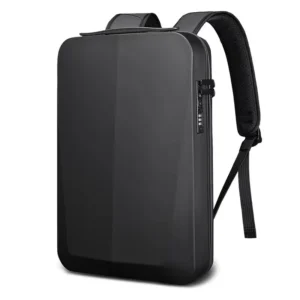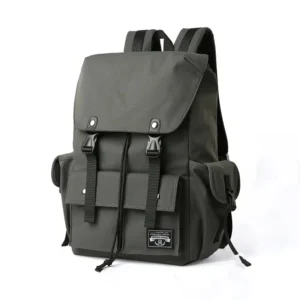Can You Ruck with a Normal Backpack? Exploring the Possibilities
Understanding Rucking and Its Benefits
Rucking, a military training exercise, has evolved into a popular fitness activity for civilians. It involves walking with weight, typically a backpack, to enhance strength and endurance. The benefits of rucking are multifaceted, including improved cardiovascular health, muscle strengthening, and mental resilience. The weight adds resistance, making your body work harder during the walk, which helps in burning more calories compared to a standard walk. As rucking gains popularity, many wonder if a normal backpack suffices for this activity. Standard options can indeed be used for rucking, provided they are sturdy enough to support added weight and comfortable for extended wear. However, understanding your backpack's capabilities and ensuring it’s properly secured are essential to maximize the benefits of rucking without risking injury.
Visit Backpack Design
Key Features for a Rucking Backpack
When selecting a backpack for rucking, certain features enhance performance and comfort. A solid structure, padded straps, and a ventilated back panel are crucial. These elements prevent strain and overheating, common issues during prolonged physical activities. Durability is another essential aspect; the fabric and stitching should withstand the rigors of carrying significant weight. A secure closure system is equally important to ensure contents remain stable. While a normal backpack can accommodate lighter rucking routines, investing in a purpose-built rucksack might be worthwhile as your practice intensifies. Additionally, consider the backpack's internal organization. Compartments that evenly distribute weight contribute to a more balanced load, shielding your back from undue stress. Ultimately, whether opting for a casual style or seeking a more specialized model, ensuring these features are present can significantly impact your rucking experience.
-
$79.90 Select options This product has multiple variants. The options may be chosen on the product page
-
$49.90 Select options This product has multiple variants. The options may be chosen on the product page
Normal Backpack vs. Rucking Backpack: A Comparative Analysis
Comparing a normal backpack to one designed specifically for rucking boils down to functionality and durability. Standard backpacks are versatile and often more affordable. They are suitable for light rucking sessions, being lighter and designed for everyday use. However, their limitations become apparent during intense rucking workouts. Rucking backpacks, on the other hand, are engineered for heavy-duty use. They typically feature specialized compartments, reinforced stitching, and are made to handle more weight without compromising the user's comfort. The most significant difference lies in their strap systems; rucking backpacks usually offer customizable and more padded straps to distribute weight evenly across the shoulders and prevent fatigue. Although a normal backpack suffices for beginners, those who plan to ruck regularly might find the investment in a rucking-specific backpack beneficial for ensuring safety and enhancing performance.

Advantages of Using a Normal Backpack for Rucking
For those beginning their rucking journey, using a normal backpack offers several advantages. These backpacks are typically more accessible and affordable. Many people already own a standard backpack, making it a cost-effective choice that eliminates the need for immediate extra investment. Versatility is another advantage; these bags serve multiple purposes beyond rucking, from daily commuting to travel needs. Furthermore, using a normal backpack allows beginners to experiment with different weights and walking distances without feeling pressured to commit to specialized equipment. Adjustability is often easier on standard bags, providing a comfortable transition for those new to weight-bearing exercises. The flexibility to adapt quickly to different environments and activities is a considerable benefit, making a regular backpack a practical starting point for anyone interested in exploring rucking.
-
$39.90 Select options This product has multiple variants. The options may be chosen on the product page
-
$79.90 Select options This product has multiple variants. The options may be chosen on the product page
Maintaining Stability and Comfort During Rucking
To ruck effectively with a normal backpack, maintaining stability and comfort is essential. Begin by securing the contents inside the bag. Use layers of clothing or other soft materials to cushion breakable items and prevent them from shifting. Adjust the straps to ensure everything lies close to your back, minimizing movement and reducing strain. Maintaining a balanced load helps mitigate the risk of muscle strain, allowing you to focus on the exercise itself. Another critical factor is packing strategically; the heaviest items should be positioned towards the bottom and close to your back. This alignment prevents undue pressure on your shoulders and back. Ensuring your backpack remains snug to your body throughout your rucking session aids in distributing weight evenly, fostering a more efficient and comfortable experience.
-
$29.90 Select options This product has multiple variants. The options may be chosen on the product page
-
$39.90 Select options This product has multiple variants. The options may be chosen on the product page
-
$119.90 Select options This product has multiple variants. The options may be chosen on the product page
-
$62.90 Select options This product has multiple variants. The options may be chosen on the product page
Tips for Enhancing Your Rucking Experience
Whether starting with a normal backpack or transitioning to a specialized rucking model, several strategies can enhance your rucking routine. Start with lighter weights to develop your technique and gradually increase the load as your strength builds. Consistency is key to reaping the benefits of rucking; aim to incorporate it into your regular exercise regime. Pay attention to your body’s signals, ensuring adequate rest and nutrition to support recovery. Experiment with different terrains and routes to keep the practice challenging and engaging. Adding intervals or changes in pace can elevate your fitness levels and prevent monotony. Engaging in communities or joining rucking clubs can also provide support and motivation, especially for those new to the activity. Regularly assessing your gear ensures it remains in good condition, preventing wear that might compromise your safety and comfort.
Overcoming Challenges in Rucking with a Normal Backpack
Rucking with a normal backpack presents unique challenges, but these can be mitigated with careful preparation and awareness. Firstly, be mindful of the weight you carry and adjust according to your comfort and fitness levels. Overloading can result in strain or injury, particularly with regular backpacks that might not have the structural support rucking-specific models provide. To counter this, consider using auxiliary support, such as waist belts, to help distribute weight more evenly. Always inspect your backpack for potential weak spots or damage, as overloaded packs can experience accelerated wear and tear. Staying hydrated and maintaining proper posture throughout your rucking sessions are crucial. They prevent fatigue and enhance safety. With these strategies, you can overcome common obstacles associated with using a standard backpack for rucking, paving the way for a fulfilling and effective fitness practice.

Embracing the Flexibility and Accessibility of Rucking
In conclusion, rucking offers a versatile and accessible workout choice, adaptable to various fitness levels and accessible with equipment as common as a normal backpack. For beginners or those wary of investing heavily at the start, using a daily backpack invites you into the rucking lifestyle without barrier, proving it’s not just about the gear, but the commitment to the exercise. Both normal and rucking-specific backpacks have their place, and your decision may evolve with your fitness journey. As highlighted, the practicality of using a standard backpack lies in its multifunctionality, but one must always ensure safety and comfort are not compromised. Embracing the principles of effective rucking—strategic packing, consistency, and listening to your body—not only maximizes physical benefits but fosters a rewarding habit. Rucking stands as a testament to the fusion of simplicity and intensity, readily customizable and accessible to all.



























